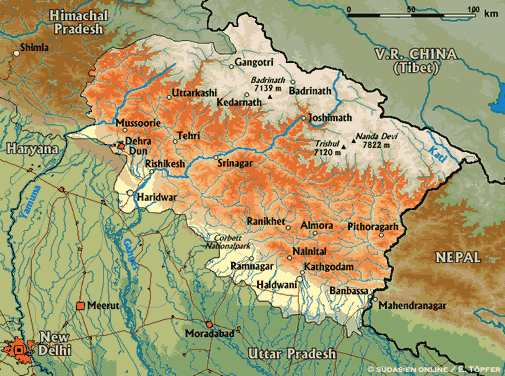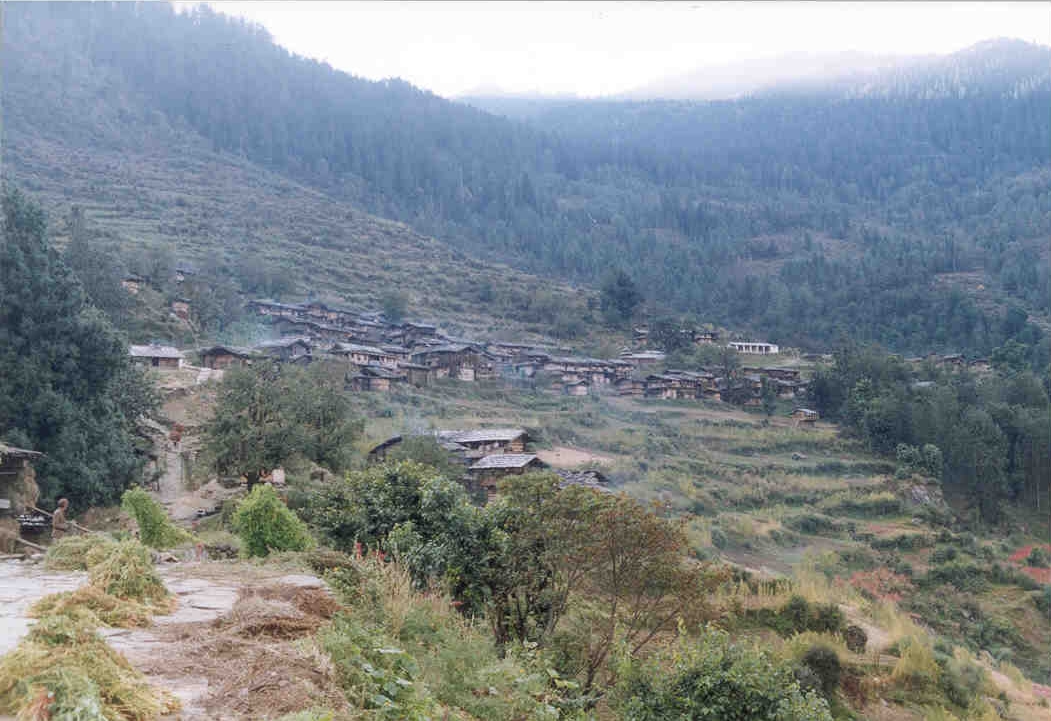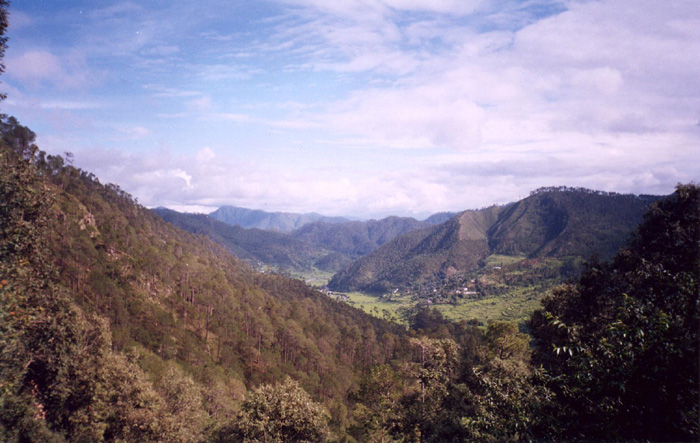- A video about the Ashram
- Lakshmi Ashram: Location
- How It All Began
- A Little about the School
- Lakshmi Ashram Homepage
A video about the ashram
Ruth Acosta and Alex Sotosonrisas from Mexico spent two months on Lakshmi Ashram and made this video about the life on the place and with interviews with Radha Bhatt og Neema Vaishnava. Video for the Befriending Project: India 2018:
![[Til toppen]](http://lakshmiashram.dk/res/oppil.png) Lakshmi Ashram: Location
Lakshmi Ashram: Location
Lakshmi Ashram is a Gandhian Basic Education school for girls, as well as a center for the inspiration and practical training of rural community activists. It is also a base for voluntary work, and a place where women from rural areas can organize themselves to define and solve their own problems.
The ashram is about half an hour’s walk by footpath from Kausani, the nearest roadside town. It is located in the middle hills of Almora District, in the Kumaon Division of a North Indian Himalayan region collectively known as “Uttarakhand.” In addition to Kumaon, this region also includes the Garhwal Division.
In 2000, Uttarakhand became a separate hill state called “Uttaranchal.” Prior to the establishment of Uttaranchal as a separate hill state, Uttarakhand was part of Uttar Pradesh, North India’s most populous state. Today, the state of Uttaranchal shares its southern border with Uttar Pradesh, its western border with another hill state, Himachal Pradesh, its northern border with Tibet, and its eastern border with Nepal. In the high Himalayan peaks to the north, the region holds four important holy pilgrimage centers of Hinduism: Gagotri, Yumnotri, Kedarnath, and Badrinath.
The Uttarakhand region is a distinctive culture area of North India, and the majority of its residents belong to an ethnic group known as “Pahari,” which literally means “of the hills (pahaaR)” in several Pahari–or hill–languages spoken throughout North India and Pakistan. As their mother tongue, most residents speak a Pahari language, usually a dialect of either Kumaoni or Garhwali, in addition to speaking Hindi as a second language. Paharis are Hindus who consider themselves to be ethnically distinct and are considered to be ethnically distinct by other groups in North India. Minority groups in Uttarakhand include several well-established Muslim and Bhotiya communities. The region is predominantly rural, village-based, and agrarian. Forest-based subsistence agriculture, together with male military service and labour migration to cities on the plains of North India, have historically been the most important sources of livelihood in the region. Today reliance on paid employment is steadily increasing, and labour migration often includes women and families as well as men.
To get to Kausani from Delhi, you can travel by night train to Haldwani or Kathgodam, then continue your journey by taking a bus into the mountains to arrive at the Kausani bazaar in the afternoon. The bus route winds along steep, narrow roads with many hairpin turns as it goes northward to Almora, the major town of Almora District. Often one must change buses in Almora to continue through to Kausani. Alternatively, it is also possible to reach Kausani by a direct night bus from Delhi, which takes about fourteen hours.
The town of Kausani is located in a scenic mountain saddle about 1700 meters above sea level. From there, you will see the snow-capped Himalayan peaks of Trishul and Nanda Devi for the first time. Kausani is surrounded by steep slopes covered with pine and oak forest, as well as neatly terraced fields in which villagers grow wheat, rice, millet, vegetables, fruits, and spices. Hill villages, many of which can only be reached by footpath, are scattered on the slopes and in the valleys below town.
For centuries upon centuries, Uttarakhand was a rather isolated region due to the rugged, precipitous nature of its landscape. However, this situation began to change during the era of British colonialism in India. As the British colonial administration’s appetite for timber grew in the mid-nineteenth century, roads were carved into the mountains to facilitate the harvest of timber for railway construction and ship building. Commercial timber extraction, which began on an intensive scale during the colonial era, drew Uttarakhand into global capitalist networks. After Independence, the exploitation of Uttarakhand’s forests by companies from outside of the area for railway ties, resin, turpentine, and pulp and paper continued apace to support the postcolonial government’s plans for rapid industrialization. Mountain slopes were also clear-cut to facilitate precious mineral and limestone mining. Over time, large-scale timber harvest in the delicate mountain-forest ecosystem created serious environmental degradation, including the destruction of ground water systems and the depletion of common village forest resources. This degradation was not passively received by village residents of Uttarakhand. Instead, timber and mining companies from outside the region were often met with vigorous opposition by villagers, men and women alike.
As their forest resources declined, village residents of Uttarakhand were compelled to change their household economic strategies to cope with depleted local timber supplies and increasingly fragmented landholdings that would no longer sustain household needs. They did so by sending male family members to take advantage of employment opportunities on the plains of Uttar Pradesh. During the early twentieth century, in order to provide financial support for their families, men were increasingly compelled to migrate out of the region to join the military or take up wage labour on the plains. Women stayed in their home villages to care for children and the elderly, as well as family households, fields, and livestock.
In the social world of a deforested Uttarakhand, it was the women of who were compelled to walk further and further each day to gather fuel, fodder, water, and medicinal herbs for their families and animals. The workload for recent generations of rural women has continued to increase. As men — except for the very young and the very old — are increasingly compelled to migrate to the plains for wage labour, women also must maintain their households without substantial help from male kin. Before the advent of commercial forestry during the colonial era, men and women in rural Uttarakhand were always busy working to make ends meet. By the middle of the twentieth century, however, women were much busier than they had ever been before, with less and less to show for their dawn-’til-dusk subsistence efforts. This situation has continued to intensify, and today many rural women must spend the better part of their day hiking several kilometers through the mountains to gather fulewood, fodder, and water to haul home for their families and livestock.
In addition to commercial exploitation of forest resources, other new patterns and institutions of modernity which took shape during the twentieth century changed life in Uttarakhand. Residents today have access to radios, televisions, vcrs, alcohol, modern clothing, and schools. These changes have had a significant impact on the lives of rural men and women. Through modern media they are exposed to the same images as residents of big cities on the plains, which has changed their ideas about themselves and their lives. Except for village children in particularly remote regions, boys and girls now have ready access to schools, and school attendance by girls has continued to grow.
However, among poor rural families, greater priority often continues to be placed upon the education of boys, since they are expected to contribute financial support to their families later on. Less priority is placed upon the education of girls from such families, because there is less opportunity for them to find skilled employment, and they will usually go to live with their in-laws after marriage. In particularly poor families, where coming up with modest school fees and payment for school uniforms and supplies is quite difficult, priority is usually placed upon sending sons to school in order to prepare them for paid employment. In such families, often the only option for a daughter’s future is to grow up to be a subsistence farmer working on her husband’s family’s terraces, rather than a wage earner in her own right. Moreover, in such families, mothers often need their daughters to work side-by-side with them to ensure that there will be enough food, water, fuel, and fodder to keep everyone going each day, so daughters may be pulled out of school at an earlier age than sons.
Marriage of daughters can pose a difficult financial burden for their families, because brides’ families are usually expected to provide a substantial dowry, and sometimes families must go into heavy debt in order to finance a match for their daughters. After marriage, which is usually arranged by the parents of the bride and groom, rural brides usually go to live with their in-laws, and help their mothers and sisters-in-law with household and farm labour. Oftentimes their husbands migrate for employment, so young wives may see very little of them. Young, rural brides are therefore in a rather vulnerable position in their in-laws’ homes, especially since the in-laws of brides from poor families are almost certain to be poor themselves. As new daughters-in-law, they may have little say in household decisions, even those which affect them directly. Their future happiness oftentimes depends even more upon the disposition of their in-laws, than it does upon their relationships with their husbands. With only limited educations and no financial resources of their own, such young women are often entirely dependent upon others for their very survival, with no real options for going forth and making their own livings should any economic or interpersonal problems arise in their in-laws’ homes.
![[To the top]](http://lakshmiashram.dk/res/oppil.png) How It All Began
How It All Began
The situation of intensifying economic and ecological transformation in Uttarakhand during the latter part of British colonial rule, together with the final escalation of the nationalist movement for Independence, set the stage for the founding of Lakshmi Ashram. Preceding the proliferation of NGOs (non-governmental organizations) in North India, Lakshmi Ashram is a small, unique institution established with the aim of educating rural women and girls, and realizing Gandhi’s dream of gram swaraj, or true independence, in postcolonial Uttarakhand. With Gandhi’s encouragement and enthusiastic cooperation from local nationalists, the institution that would become known as Lakshmi Ashram was founded in 1946 by Gandhian follower Sarala Devi, formerly Katherine Mary Heilman of London.
In the 1920s, Sarala Devi had come into contact with Indian students and followers of Gandhi in London, and was very moved by reports of the growing nationalist movement there. On June 4, 1932, at the age of 31, she boarded a ship in Liverpool and came to India in order to join Gandhi’s nationalist movement. She participated actively in the freedom struggle against British colonial rule and was imprisoned twice for this reason. However, by 1941, her health had become so poor that Gandhi sent her to the hills of Kumaon to recover and to see what sort of work she could do with Gandhians there. She began to feel better shortly after arriving in the mountains, and soon began to work again. She became actively involved with the anti-colonial struggle in the hills and with work to improve hill women’s living conditions.
Sarala Devi founded the ashram as “Kasturba Mahila Utthan Mandal” in memory of Gandhi’s wife, Kasturba. It was set up as a Basic Education program where girls would receive an academic education along Gandhian lines and be trained to become social activists who would with self-confidence work to become self-reliant and to uplift their village sisters in Uttarakhand. This mission was expressed by Sarala Devi’s choice of name for the institution: Mahila Utthan Mandal means an organization or collective (mandal) for the uplift (utthan) of women (mahila). The original girls’ school was located in a four room house named “Lakshmi Ashram” that had been donated in 1946 by a local Indian Civil Service officer, nationalist, and landholder, who had named it after his wife, Lakshmi. Residents of the immediate area in those early days referred to the new institution as “Sarala Ashram,” and with the passage of time it became widely known simply by the name of its first donated building, as”Lakshmi Ashram.” In 1967, the management of the ashram was taken over by Radha Bhatt, an ashram teacher from Kumaon. In 1989, she passed the responsibility for managing the ashram on to a group of ashram workers, all whom are women from the region.
![[To the top]](http://lakshmiashram.dk/res/oppil.png) A Little about the School
A Little about the School
Lakshmi Ashram usually has between sixty and one hundred residents, including about ten teachers. The students range in age from about seven to twenty, and are distributed in ten grades of classes. Most of the women and girls at the ashram come from Hindu villages in Kumaon, although some come from the Garhwal Division of Uttarakhand. Some also come from Dalit (often referred to as “Harijan” or “Untouchable”) or Bhotiya (a minority ethnic group in the region) families, and many come from troubled backgrounds. Adult women at the ashram are sometimes widows, and some have left abusive marriages. Some women and girls there have minor physical handicaps. For many women and girls, training at the ashram is their only means for achieving the self-confidence and self-reliance necessary to lead dignified adult lives.
The school considers it to be of great importance that the women and girls at the ashram live and work together irrespective of caste and other social differences among them. Most of the students at the ashram today are from extremely poor– sometimes landless–families. They are often without two living parents, and some are orphans. Others are from particularly remote villages where access to post primary school is still a problem, especially for girls. Most come from small, off-road villages and relatively uneducated families; the mothers of many of the women and girls there today have not themselves attended enough school to learn how to read and write. Hardly any of the families of students at the ashram today are able to pay for students’ school fees, room, and board. Funding for running the school comes partly from Indian sources, and partly from donations from abroad. Since 1969, Lakshmi Ashrams Venner, a Denmark-based group of friends, has been an extremely important source of funding for student scholarships and other ashram projects. Nearly all of the students at the ashram today are funded by Lakshmi Ashrams Venner-sponsored scholarships.
The ashram owns eleven acres of land, six of which are cultivated terraces, and five of which include meadows and forest. Cows are kept to supply milk for ashram residents. Students and their teachers work together to care for the land and animals. Ashram facilities include a main building which houses classrooms, a group meeting room, a dining room, a kitchen, an office, and a sick room. By night, the classrooms also serve as dormitories for students and their teachers. Along a footpath just past the main building is a washing house, where the girls




